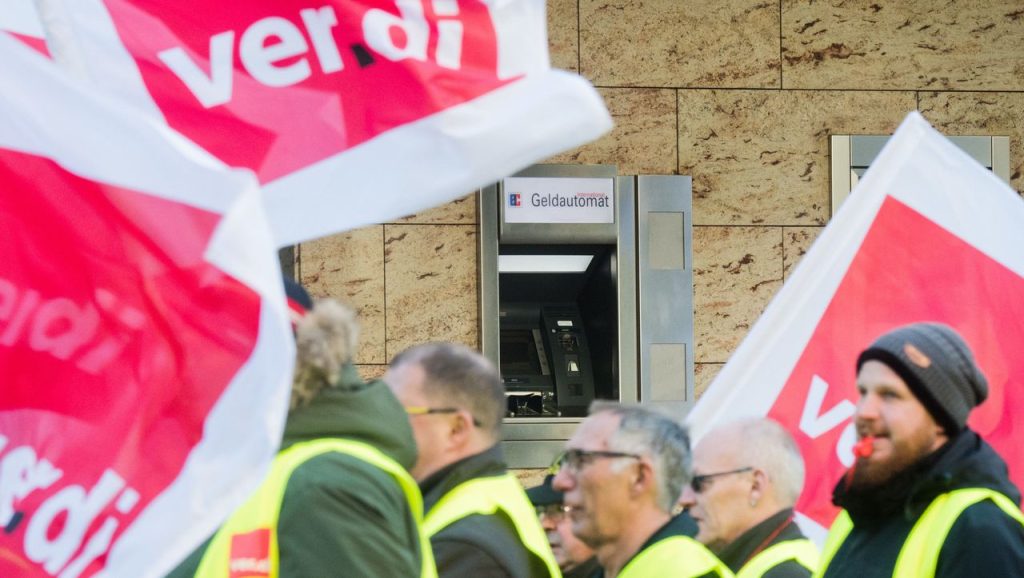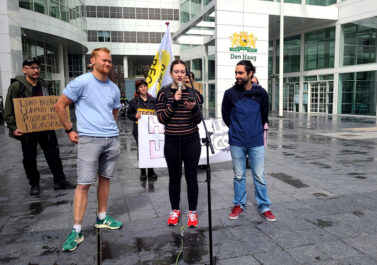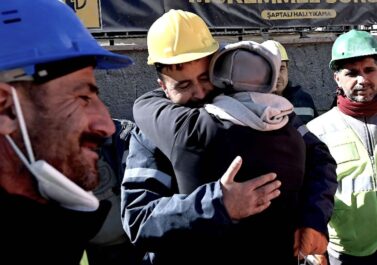
We translated this article by comrades from Communaut about the recent public sector strikes in Germany.
The collective bargaining disputes in the public sector at the beginning of 2023 were quite intense. Against the backdrop of war, inflation and energy crisis, up to half a million workers took part in strikes, and the trade unions subsequently recruited tens of thousands of new members. Leipzig public transport company workers were part of this surprisingly large strike mobilisation, which had an especially strong dynamic in East Germany.
We talked to Paul about the reasons for the strong character of the dispute, the perspectives of an ecological public transport transition in East Germany, and the role played by his trade union shop steward group. He works at the Leipziger Verkehrsbetriebe (LVB) (Leipzig Public Transport Company) and is active in the Ver.di works group there.
***
Good strike, bad result. Could the strike at LVB be reduced to this? After all, many records were broken during the mobilisation: for the first time since reunification, there was a 24-hour strike in Leipzig and there was also a strike at a Champions League match. At the same time, however, the wage settlement fell short of the union’s demands. Can one therefore speak of a discrepancy between strike strength and its result? Could the pressure have been increased and more achieved?
Unfortunately, the answer is not that simple. First of all, the dispute affected the entire public sector i.e. about 2.5 million workers. Formally, we as LVB were only involved through a so-called participation strike, because although the results of the TVöD [public sector collective contract] are transferred, we are not part of the TVöD. It is true: the mobilisation was outstanding by our standards. But, if we look at the public sector as a whole, the picture is somewhat less clear. Since the 1990s, the public sector has been privatised and liberalised by various governments. Politically generated cost pressure has worsened working conditions. Important parts such as the railways or local transport broke out of the TVöD. This was followed in the 2000s by the split into TV-L and TVöD – the TV-L is the public sector contract negotiated for each individual federal state, the TVöD is valid for the whole of Germany. The trade unions’ ability to assert themselves in the public sector was thus weakened, and the demoralisation resulting from the deterioration did the rest to lower the level of organisation in this sector.
This structural weakness was also reflected in the strike movement, which was carried out by relatively few well-organised and mobilised workplaces. Whether and how a mobilisation for the round of collective bargaining took place at all also varied quite a lot across the different Ver.di [service sector trade union] districts. In Leipzig and Berlin, for example, the round was organised quite differently by the local full-time structures than in many other districts. But even within the districts there were quite a few differences in terms of the companies. For example, the LVB colleagues were always in the majority in the organising committees and assemblies, i.e. the local and district coordinating committee for industrial action, compared to all other public sector companies. Large sections, such as the city administration, were hardly represented or mobilised at all. From a distance, I have the impression that the situation was similar in Berlin, for example, where the experienced colleagues from the hospitals and the municipal cleaning workers, who were mobilised through ‘organising’ [original in English], played a leading role.
In any case, this year there were significantly more people involved, there were more warning strikes, but they started from a very low level and with historical deficits that could not be overcome within such a struggle. Nevertheless, the movement would have had the prospect of greater success. Tens of thousands of new members, 100,000 in the first half of the year, and an increasing participation in the strike actions speak to the fact that there was a potential, but that it was not fully used.
Why was the mobilisation so successful, what was different this time?
In my view, two factors were decisive for the successful mobilisation: on the one hand, the strong economic pressure to which many wage earners are exposed. For many, the price shocks have caused painful levels of impoverishment and caused worries about how the general situation would develop. The colleagues in the driving service in particular also suffer considerably from their working conditions, as a constantly high level of sickness related absence shows. Secondly, at least in some districts, Ver.di had conducted this round of collective bargaining quite differently from the previous one. In Leipzig and other cities there was a large-scale campaign to build up strength, which started several months in advance and was driven forward by ‘organisers’. This activating, ambitious and militant approach to the struggle reached many workers and gave them the feeling that, for once, something was at stake and that the union was ready to really fight for it.
In concrete terms, the mobilisation took the form of so-called strength tests. This is an instrument of the organising approach that is currently very popular in parts of the trade unions. First, demands were developed and discussed in the companies, followed by a petition for these demands, for which a majority was to be won. With the beginning of the hot phase, the relatively new tactic of so-called work strikes [Arbeitsstreiks] was used. These are warning strike calls directed only to the more active sections of the workforce – rather than being a general call to all members – and where the paid officials of the union take on all organisational tasks. They come together to organise strikes and demonstrations, to discuss the progress of the negotiations or to mobilise other colleagues. In general, the organisation of the strike was put in the hands of the workers to some extent. Groups were set up in the different parts of the company to organise the pickets on the spot. A company and a district industrial action committee consisting of delegates from the various companies was set up and was expected to resolve at least many of the mainly practical issues itself. These assemblies became places of self-activity and discussion. This self-activity released enormous energy and potential among the active colleagues. The strike was actually carried by the workforce and was thus able to bring out many of the initially sceptical workers. It has to be said, however, that districts like Leipzig and Berlin were exceptions to the rule – in other districts, the main officials probably stuck to their usual routine.
The Ver.di national level also set the larger framework. How many strike days there should be and at what point in the negotiations could only be influenced to a limited extent by those affected. Neither was there any questioning of the agreed arbitration process, which shifted the dispute into secrecy after the third round of negotiations and demobilised the colleagues for quite some time due to the legal obligation to keep industrial peace during the arbitration process.
How did the general public in Leipzig react? Did more people than usual express their understanding or support for the strike?
The impression from the pickets was very positive in this respect. People came by and brought food or donated to the strike fund. Many leftists also supported the strike, regularly showing up at the picket lines and at the demos. In addition, there were some opportunities for talks with workers from other companies who not only sympathised with the strike, but also took the chance to exchange views on the possibility of setting up works councils at their companies. Probably not much came out of it, but people related the strike to their situation and recognised themselves in it. That’s something. And if the surveys are to be believed, the support for the strike remained quite high until the end, and that was despite an intensifying public campaign to demonise the strikers.
How did Ver.di deal with this surprisingly strong mobilisation?
Well, it was a mobilisation that Ver.di had caused itself, so it was not at all embarrassed by having to react to something unforeseen. Perhaps one could rather ask: why did they organise such an elaborate and combative collective bargaining round in the first place? It seems obvious that the high inflation and the heavy real wage losses of workers have naturally put pressure on the unions. In the public sector, however, the employers managed to push through a nasty wage deal (3% wage increase over 28 months) in the last collective bargaining round, which took place during the pandemic. With its decision to commit to the economic war against Russia, to push ahead with rearmament and to stick to the economic goal of reducing public debt, the government has made it clear that wage increases in the public sector are not on its list of priorities. The various municipal enterprises of the public sector point to their tight coffers and have been extremely stubborn in the negotiations. The mobilisation could therefore be understood as an attempt to reach a deal under difficult political conditions and with little fighting power, which would put a stop to the deep demoralisation and loss of importance of the union in the public sector.
At the same time, this also indicates why the Ver.di leadership and also the main union officials did not push the mobilisation further, why the forces that wanted to compromise were finally able to prevail in the bargaining commission. During the dispute it became clear how determined parts of the municipal employers were. Even after the arbitration, the municipal enterprises in Saxon, for example, tried to prevent the transfer of the so-called inflation compensation payment to the participating transport companies. In addition, the courts have sometimes blocked further strike action in recent months, for example when the strike in the Elbe tunnel was banned on the day of the big transport strike or when the EVG (railway and transport union) had to withdraw its strike call by court order. The fear that the strike front would collapse if the employers continued to refuse seems understandable against the background of the structural weakness vis-à-vis the employers. The last time there was an all-out strike in the public sector was in 1992, and at that time important companies like the Bundesbahn were involved.
Thus, not only was there a lack of clout, but also a lack of experience among the leaders on how such an all-out strike could be organised and enforced. On the other hand, the DGB (trade union federation) leadership itself had given its blessing to the government’s proposal for a one-off payment as a substitute for wage increases within the framework of the so-called Concerted Action – a negotiating pact between trade unions, employers’ associations and government to prevent industrial disputes. Ver.di, in turn, interpreted the vote of postal workers in favour of an all-out strike as a sign to start negotiations and enter into this horse-trading with the employers. And the result at the post office was of course immediately imposed by the employers as a yardstick for our negotiations.
But there are also deeper reasons why the dispute could not be taken further: firstly, the hegemony of a social partnership orientation in the leading institutions of the union. The low level of disputes in recent decades has also been reflected in those union bodies of union representatives who are not paid officials. There are people on the bargaining committee who were elected at a time when little was happening and who simply could not or would not keep up with the movement. The Leipzig delegate actually only managed to appear at one of the numerous strike meetings after the negotiations broke down. In the end, the Federal Collective Bargaining Commission reflects the state of the trade union movement with a certain delay. The previous struggles in the Berlin hospital movement, for example, made it possible to send militant colleagues to the commission, but they remained in a minority.
Finally, the workers who have recently been on the move suffer from a lack of experience and self-confidence that could not simply be overcome in the course of a collective bargaining round. Class antagonism has become more tangible than before due to the passing on of price shocks to wage earners. Many personal conversations bear witness to this, but generalisations and exaggerations about the current attack on our wages have also been expressed in speeches during the strike. At the same time, however, there is a lack of a grown and stable political identity and consciousness, which would have been necessary to lead the struggle from below. Since Ver.di was confronted with an opponent who was not very willing to negotiate, the strike mobilisation had to be very different from the usual ritual: the self-activity of the colleagues was promoted and the necessary common identity was pushed more strongly. However, both – self-activity and collective identity – remained largely within the framework set by the union.
When the union declared the threat of a collapse of the strike front and glorified the compromise, the fear of losing everything in the event of a further escalation spread, at least amongst us. A possible all-out strike suddenly appeared to be the greatest danger. The Ver.di leadership was obviously not ready for such a strike, since they had a compromise that could, with major efforts, be sold as a partial success. This would have required a greater willingness to take risks and an effort to prepare the workforce, but also the Ver.di structures on the ground, for a real struggle. In the workforce, on the other hand, there was a lack of awareness and self-confidence to draw the top brass and the fickle colleagues into an all-out strike. The end result is a zero increase for 2023 and a wage increase for 2024 of sobering dimensions if we take into account both high inflation and strong mobilisation during the pay campaign.
We recently reported on our blog about the meeting of a campaign for a green public transport transition in Wolfsburg, where people are demonstrating and arguing for a changeover of the car industry from individual transport to public transport. To what extent do your colleagues relate to this role of public transport companies in the struggle for an ecological change in transport, both during the strike and in general? Does climate change play a role?
This is a tricky issue. The reactionary political mood in Saxony is also noticeable here. Ecological questions are an irritant in parts of the workforce, charged by the successful ideological shift of the class conflict to a cultural conflict that hides the essential connections, but that articulates itself all the more brutally for it. At the same time, there is an interest in expanding or at least better financing public transport. Through the efforts to create alliances that the left parts of the climate movement have been pushing since 2020, the issue is also constantly present and has been discussed again and again at the picket lines.
Ver.di has meanwhile formed a top-level alliance with the climate movement called, “We ride together”. This alliance led to at least a symbolic event this year: transport workers and climate activists went on strike for the first time on the same day and together. On the 3rd of March, a call was made for a global climate strike and a warning strike in the participating transport companies. There were joint actions at the picket lines and a small trade union block joined the climate demo. A change in consciousness is certainly emerging among some workers, both in terms of openness to the left climate movement and to ecological demands. The influence of the conformist rebellion from the right remains strong, but at least the prejudices that are promoted by the right-wing are being rejected by a larger number of people. A political force that could systematically explain the everyday sufferings and offer a convincing vision for overcoming them is unfortunately not in sight, and this does not make it any easier to win the confrontation with the right-wing.
What did your efforts as a workers’ group look like within the strike? What role did you play?
Probably the biggest role was played by our shop stewards’ group as an independent association before the strike really got going. At an extraordinary works meeting last autumn, we were able to denounce the grievances in the company in a speech to the applause of hundreds of colleagues and thus give the starting signal for the collective bargaining round. Many were enthusiastic about the fact that the various dissatisfactions were articulated in a confrontational way towards the management, and some became active in the union as a result of the speech. In the mobilisation phase we collected signatures for the petition, distributed leaflets and simply spent a lot of time in the break rooms and offices talking to colleagues. When the strike started, most of the activists were elected to the delegate structures and then absorbed by the work there or on the ground. The additional meetings of the shop stewards’ group fell victim to either being overstretched or conflicting schedules. In the beginning we still managed to write speeches together, but in the end resolutions, speeches and other interventions were almost only due to the initiative of individuals.
The role that the shop stewards’ group or parts of it played in this phase was that of a certain political leadership, while organisationally it increasingly lost importance. In these interventions, attempts were made to move the dispute out of its partly professional or sectoral framework and to make it transparent and sharpen it as part of a class dispute. For example, there were demands to coordinate the different strike movements of the post office, railways and public services, and there was pressure for control of the negotiating and federal bargaining commission by the strike delegates. These advances were symbolic because they were not supported by a significant core of workplace activists. But during the peak of the movement they had a great resonance. How weak our influence ultimately remained can also be seen in the ease with which the strike was wound down after the arbitration process started. Those who were against the acceptance of the arbitration result remained in the minority despite the high levels of tension that were prevalent before.
What was your relationship with the trade union apparatus during the strike?
As a Ver.di shop stewards’ group, we maintain a relatively close, if not entirely smooth, relationship with the Ver.di apparatus of full-time officials. But while under normal conditions we mainly work with our trade union secretary, during the strike the organisers sent to us came on the scene and we worked with them quite intensively. During the upsurge of the movement, there were no significant conflicts of interest.
Of course, the resolutions to bind the negotiating commission members more closely to the will of the union rank-and-file did not meet with the approval of all the full-time members, but since these resolutions were inconsequential, there was no potential for conflict. Conflict only arose over the outcome of the arbitration process, when leading persons from the main office did a u-turn that came as a surprise for many, when they suddenly defended a compromise against which we had been sharpening arguments together for weeks. For some, this was a shock that led to disorientation. The isolated confrontations were short and fierce, but without major consequences. Now, of course, we are continuing to work as a Ver.di shop stewards’ group. However, some colleagues have become aware that Ver.di itself is not a homogeneous structure and that conflicts of direction also run through the trade union movement, be it within the union, between the union and the workforce, or even within the workforce itself.
Did the strikes create a basis for coming disputes, or were the unions able to channel the anger and contain it through social partnership?
As I said before, it would be more accurate to say that the Ver.di mobilisation was the first time that the anger found a productive expression. Instead of bottling up their frustration, resigning or ranting to themselves, colleagues organised themselves, went on strike, discussed, demonstrated and won a little something through this struggle. Individual colleagues have left in protest against the agreement. Most of them, at least in our case, seem to be reasonably satisfied with the result, which is also better in our case than in the public sector itself, due to previous and still valid collective bargaining agreements. To our regret, many colleagues have withdrawn from taking initiatives for the time being.
What remains, however, are the activist structures and communication channels that have emerged during the movement and with which we can reach hundreds of colleagues directly. The shop floor group has gone from being a largely insignificant marginal phenomenon to a place of exchange for a growing number of shop floor activists. Finally, we have brought together the various structures that emerged in the different phases and thus – at least we hope – also created a structure for workplace work that is sustainable in the long term. In this respect, the answer to the question must be: both. The basis for further disputes has been improved, but these disputes will remain within a framework of social partnership for the foreseeable future.
For this to change, there would need to be a larger network of activists in the workplaces who have acquired the theoretical and practical tools necessary to act as a driving force in such struggles. Since independent workplace structures with such an orientation and the corresponding capacities do not exist anywhere, targeted support from outside would be all the more important. So far, however, there is hardly any talk of this. Bringing cakes to the picket line and participating in demonstrations is not yet targeted work to rebuild working class organisation. In any case, the collective dispute in the public sector has made clear how weak and unconnected the more conscious forces are at the moment and how random the support from the organised left is. So there is a lot to learn and to do.



